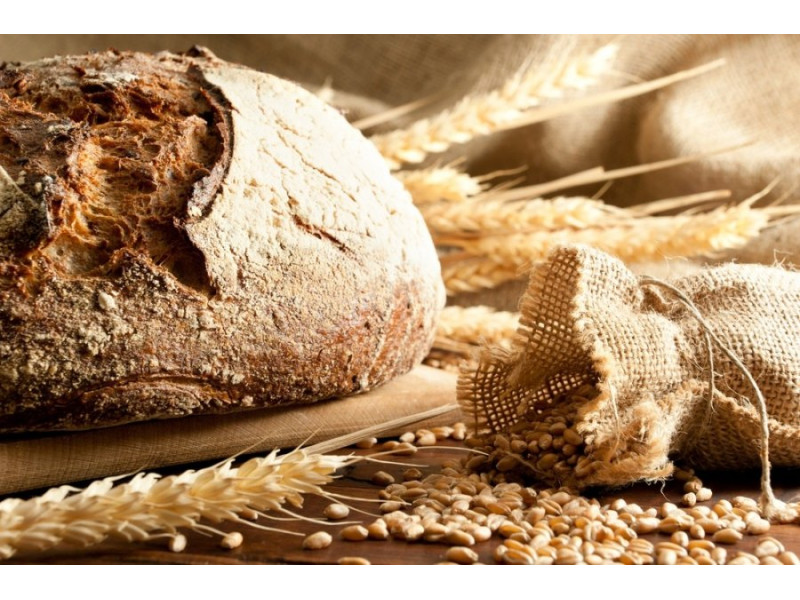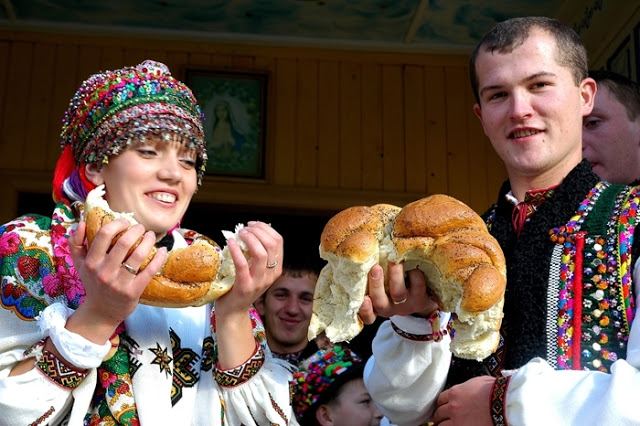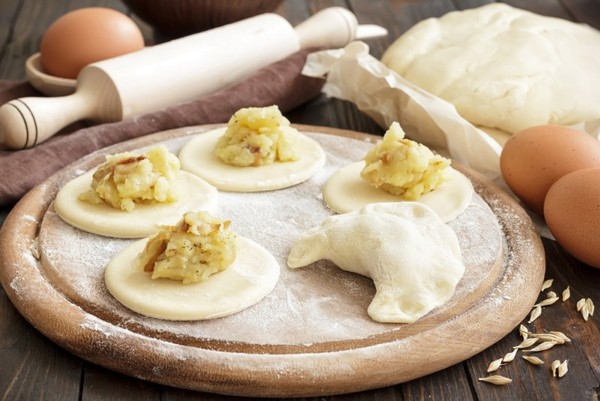What is ritual bread? This is the name given to dishes that are a product of agriculture and have ritual use. Loaves, festive kalachi, bagels, wedding diven, varenyky, Christmas knyshch, and finally porridge or grain in general, which are also used in various rituals.
A long time ago, even in the time of our ancestors, the Slavs treated with respect and honor people involved in growing bread and all the activities related to it. After all, there was nothing more important in human life than bread, which occupied almost the most important place in culture, rituals and religion. The Slavs, so accustomed to the fact that it is always on the table and is a symbol of abundance and life, in years of poor bread harvests felt hunger and suffered, although there was plenty of food in the forests - game, fish, berries and roots. According to the legends of many peoples of the world, the very first plowman was the Lord God himself. This can be found in German, Greek, Persian culture. Ukrainian carols, for example, depict God and the greatest saints in the image of farmers.
Residents of different regions of Ukraine believe that there were times when there was a general abundance of everything, including bread, and hunger was unknown to people. In those days, grain grew from the ground itself, filling the entire ear of corn, and such a rich ear of corn was called a “stokolos.” And one day, Christ and his apostles were passing through a village. He went to someone’s house and asked for something to eat, including bread. At that time, the hostess was baking pancakes in the house. She became very angry with the people, who seemed to her to be beggars, and instead of bread, she threw a pancake, with which she had previously wiped the child’s footprints left on the bench. Christ was very indignant at the insult to the bread, so he went into the field and ripped off such a stokolos from bottom to top. The owner’s dog saw this and began to howl, and the apostle Peter began to beg Christ to leave at least “for the dog’s share” of grain on that ear of corn. And so it happened, and since then people have eaten no more than a "dog's share" of bread.
There was another legend, repeated in different versions by many peoples. According to it, grain was originally intended for dogs to eat. But man snatched that grain almost from the dog's mouth and began to grow it all over the earth. Since then, dogs cannot be killed and eaten, because people eat the rations intended for dogs.
People respect and honor bread, and so they say about it - "holy bread". It is considered sacred and it is a great sin if a person plays with it or throws away even the smallest piece of it. There was a belief that a person who treats bread improperly will constantly collect the crumbs in the afterlife that he threw away in his earthly life. The rest of the bread was always fed to domestic animals, sometimes burned in the oven.
Bread has always personified prosperity and wealth. When people said “bread and salt,” they were inviting wealth into the home. They also offered sacrifices of bread to household spirits, so that the housekeeper would receive a piece of it, to the spirits of the earth – for a good harvest, to the spirit of water – the waterman – to appease him and so that he would not drown people and livestock.
Folk beliefs contrasted bread and evil spirits, separating them into different poles. For example, to prevent the viper, which personified evil spirits, from attacking, people also took a piece of bread with them into the forest - as a pledge of good. They blessed them with bread, because they saw it as a talisman against misfortune. Young couples were also blessed by their parents with bread. They were seen off on a long journey, met with bread and salt, this ritual generally had a very great cleansing power. Coming from a distant foreign land, a person could bring with them something evil, hostile, something bad, and only bread could drive away someone else's power and intentions. People believed that even bread could stop a fire, if it were placed around a burning building.
A promise made with bread can never be broken. When concluding important agreements, whether commercial or land, loaves of bread were exchanged. During a matchmaking ceremony, the matchmakers would bring their loaf of bread to the house where the girl was waiting, and instead, if the girl agreed to the marriage, they would receive a flatbread. In some regions, a special cake was baked for the matchmaking ceremony, which was divided in half during the matchmaking itself: one half was given to the groom's representatives, the other half was left with the bride's parents. This ritual resembles communion. In ancient times, all people who ate ritual food at one ritual table were then considered accomplices in the matter that was to be. Previously, it was just a rite, but later it grew into a permanent tradition to conclude any important work with a large, rich feast, with a large number of dishes. At the head of such a table was to be one most important "bread" dish, which had only a ritual character and was not consumed.
Today, bread also plays a significant role in the rituals of the Ukrainian people, whether wedding or funeral. If we look at the quantity and completeness of the ritual bread used in them, then the wedding takes first place among the ritual events. The matchmaking begins with the exchange of bread, which means consent to further actions, and continues in the barn, where loaves of bread are laid out in the corners and on sheaves of rye the newlyweds spend their first wedding night.
A wedding loaf is of particular importance – it is baked solemnly and respectfully. In some places, all the women who were already married, from the bride’s family, took part in the process. Special songs were sung at each stage. The women who baked this loaf were called korovaynitsy, and only those women who were happy in marriage could be them. The senior korovaynitsy stood above them. All the women decorated themselves with periwinkle wreaths and came to the bride’s house before the wedding, usually on Thursday. The overnight stays were laid out, flour was prepared, the best of what was available, sieves were prepared, etc. The process of baking the loaf itself began with sifting the flour. The men kneaded the dough, women could not even look into the barrel – this was strictly forbidden. Only the man had the right to put the loaf in the oven, but all the bride’s relatives who were in the house could hold onto the shovels. These rites and rituals had very simple symbolism: the oven and the bowl represented the female womb, so it was categorically impossible to violate traditions and prohibitions, so as not to lead the bride to infertility.
The loaf should have a round shape, its size spoke of the wealth of the bride and groom's parents. The loaf was decorated with various patterns on top. Often among them you could find motifs of the world tree, ears of corn - all these were symbols of well-being. Birds were sculpted and planted on top. The image of the sun and moon on the loaf meant the couple. Sometimes tree branches were inserted into the baked bread, and small money was placed inside. If a person found a coin in their piece of wedding loaf - they were lucky.
For the wedding, they also baked lezhni, šishki - small buns made in the shape of cones, or diven - it was a round bread with a hole in the middle. When the bride left for the groom's new house, she looked towards the sunrise through the diven - then the children would be beautiful. She could also see her future and marital fate through the hole.
Bread is also actively used in funeral rites. The ancient Romans and Greeks prepared sacrificial dishes for their deceased relatives on graves. Now in Ukraine, the coffin or the path where the deceased is carried is covered with rye grain. A whole loaf of bread is placed on the coffin lid. A glass is placed on the grave and a pie or piece of bread is necessarily left next to it. The same is placed in the house where the deceased lived, without touching it for forty days, because during this time the soul of the deceased will come to taste the left dishes. For the memorial dinner, sweet porridge, flavored with raisins or honey - kolivo, and pies are prepared, this tradition has survived to this day. In addition, in Polesie, unleavened cakes are baked, which are shared among those present, called a memorial loaf.
When the fortieth day arrives, the coffin with the deceased is "sealed": they take earth from the grave three times in a cross pattern, a little bread, honey, and salt, mix it all up, and take it to church. The priest serves a memorial service for the deceased, and the earth is then returned to the grave.
All folk holidays were accompanied by the consumption of ritual bread. These are such peculiar traces of the former sacrifices of our ancestors to higher powers. Christmas coincides with the holiday of pre-Christian times - the winter solstice, on this holiday they eat kutya. This is a special dish made from boiled wheat (can be replaced with barley), nuts, poppy seeds, honey. Bread is eaten on this day only as a supplement to the main dish - kutya. With this bread, the peasant blesses the livestock before the Holy Supper, saying ritual words about invoking good and avoiding evil spirits and evil spells.
Then, each animal is given a piece of bread with a mixture of various holiday dishes - so that the livestock will be well and satiated in the new year.
A very interesting rite is performed on Shchedry Vecher, which shows the sacred meaning of bread. A festive dinner was held, after which the owner gave the livestock a “pie,” that is, a loaf of bread with a cross on top. At the same time, he ordered that God was coming and bringing the pie. Then he blessed the animals with the bread, which was divided among all the livestock.
The inhabitants of Galicia bake a krachun for Christmas - a large white bread. It is placed in the middle of the table between other dishes and is covered with small krachuns. When the first star appears in the sky, they announce the arrival of the krachun, and only then does the festive dinner begin. It is likely that the krachun personifies the solar deity, who was reborn and became an occasion for celebration. Kaleta has a similar meaning to the krachun - a large unleavened bread made from white flour. It was baked before St. Andrew's Day. Kaleta was decorated with dried cherries and raisins. All the girls who lived in the village prepared it. The baked cake was hung from the ceiling in the house where the evening parties were held, with the talkative "Pan Kaletinsky" standing next to it, holding a kvacha dipped in soot. That gentleman invited “Mr. Kotsiubynsky” to “bite the kaleta” (this gentleman could be anyone present in the house). The participants in the game took the kotsiubynsky between their legs and took turns approaching the kaleta. The guard took turns having a humorous conversation with them, trying to make “Mr. Kotsiubynsky” laugh in any way he could. If he even smiled, Kaletynsky would smear his lips with his kvacha, and the next player would go to the kaleta to bite it.
This game is a fragment of a traditional myth of the abduction of the sun (or in some versions, it was swallowed). The mythical hero Pan Kaletinsky protects the sun; soot was once a sacred thing, because it was associated with fire, and the very name "kaleta", according to some versions, is nothing more than the changed in the speech process of "kolyada". The very custom of playing this game in ancient times was part of the ritual games at Christmas. Later, it somehow passed into the pre-Christmas holidays.
On the Generous Evening, pies were traditionally prepared. The Hutsul region prepared varenyky for this day, the Dnieper people - pies with meat and fried pancakes, and Southern Ukraine made bagels. But all these dishes, despite their diversity, all had the same ritual name "pie". When the festive dinner began, a bowl of pies was placed on the table, and the father sat in front of it, bowing his head as if hiding. The children asked their mother, as if they had not seen him, where was dad, and the father answered from behind the pies, unless they could not see him. The children replied that no, they did not see him, to which the father ordered that God would give and that next year they would not see him like this. This rite was intended to drive away misfortune, to pave the way for prosperity and well-being in the coming year.
Ukraine cooked dumplings for Maslenitsa, ordering that even the busurmen eat dumplings at this time. Once this dish was exclusively ritual and was associated with the cult of the moon. Girls also cooked dumplings and gave them to boys on the day of the Forty Holy Martyrs, which was March 22. At the same time, they said that the frost would not kill the lovage. On this day, forty honey cookies in the shape of birds were baked and handed out to children so that the bird would be found. This was actually a kind of sacrifice, because if forty larks fly from the nest on this day, then spring would soon begin.
During Great Lent, after Maslenitsa, special types of bread and bread products were made. On the first day of Lent, for example, special dry cakes, the so-called "zhilyaniki", were eaten in the country. They were a great contrast to the rich Maslenitsa dishes and were supposed to remind us of the restrictions and restraint of our desires in the following months of Lent. When the fourth week of Lent came, Ash Wednesday came, and in the houses, loaves of bread in the shape of crosses were baked, sprinkled with poppy seeds and smeared with honey. Some of these loaves were eaten, the other part was saved until sowing, thus making a sacrifice to the spirits of the fields.
A special and very important place among the ceremonial breads is occupied by paska, or baba, as they are sometimes called in Ukraine. The Easter bread itself was different from the others, it was unleavened, rectangular in shape and was directly associated with male symbolism. The fact that the bread was made unleavened indicated its antiquity, because the recipe for unleavened bread appeared much earlier than kvass. And the connection with male symbolism said that the bread was associated with fertility, because it was dedicated to the underground god, whose symbol was a rectangle - in many types of art it denoted a field. Later, the phallic shape became a symbol of fertility, which was also reflected in Easter bread.
Winter and spring holidays were richer in dishes and food than summer ones, in which more rituals were combined with the aim of expressing respect for the spirits of fertility, the souls of deceased people. After all, the future harvest depended on this respect. Freshly baked bread was put out on the window during Green Week so that mermaids could eat steam from it.
One of the largest calendar and ritual holidays was also associated with the upcoming harvest, namely the day of Ivan Kupala. The idol of Kupalo, as evidenced by ancient Ukrainian chronicles, was the god of the fruits of the earth, so sacrifices were made to him when the harvest began. On this day, peasants tried to arrange meals in the field, on the edge, where among all the delicious dishes, dumplings with cheese occupied a very important place. On this day, Belarus baked babki, that is, unleavened pancakes, dumplings made from buckwheat flour and crushed hemp seeds. The inhabitants of Serbia prepared kretni kalachi - a round bread made from wheat flour with a large cross on top. A candle was inserted into this bread, a priest read a prayer over it, and then everyone present at the ritual ate a small piece of this bread. This was also a form of sacrifice, and after it they partook of the body of the victim. Girls in Russia gathered on the eve of the Kupala holiday in one selected hut and pounded "barley in a mortar": then the next day they cooked porridge from it, which they ate in the evening with cow's butter, and this porridge was called kutya.
These peculiar bread rituals accompanied many economic activities: plowing, sowing, harvest and harvest festivals, and the rest could not pass without them. At the same time, each of them went hand in hand with a dinner, where certain special dishes were made from flour. At the beginning of the harvest, for example, housewives in Ukraine cooked dumplings, harvest festivals began with a huge loaf of new grain, which was distributed piece by piece to the harvesters and relatives. The beginning of the harvest in the Czech Republic is associated with the yarn - ripe grains of grain crops were baked in a frying pan. Housewives in Bulgaria baked turta after the harvest, that is, unleavened bread smeared with honey, which was also distributed to family members and neighbors.
It is worth saying at least a little about porridge. Porridge and bread were considered dishes of the same order from a mythological point of view. The use of porridge, which is part of the ritual, is closely related to the use of bread and grain in rituals. This can be seen in the mythology of different peoples of the world. In India, barley porridge was offered as a sacrifice to Pushan, the god of cattle breeding. The Romans prepared porridge on a child's birthday. The ancient Germans had a similar ritual on the holiday of Berhta (Golda), a female deity. Its prototype is the Great Goddess. The phraseologism "to brew porridge" has survived to this day, signifying the beginning of an important and complex matter.
Thus we see how on various calendar and ritual holidays it was customary to eat porridge, in particular kutya. They also mentioned kolivo at commemoration. We can also add about kolivo, which women prepared on the first Saturday of Great Lent, on the day of remembrance of the dead. A small pot full of kolivo and honey was taken to church and a panakhida was held over it.
In addition to these rituals, porridge was also used generously in ceremonial wedding dishes. Even the word "porridge" was closely associated with wedding celebrations. At princely weddings, porridge was served to the newlyweds. When the general meal ended, the newlyweds took a few spoonfuls of porridge and threw it at the ceiling - this was a sacrifice to the gods and spirits. The same was done on Christmas Eve - with kutya: if the kutya sticks to the ceiling - the year will be fruitful.
Residents of Boykivshchyna give porridge to the newlyweds on the day after the wedding. In some regions, only the bride consumes porridge. There is a connection with the birth ritual, where porridge was a symbol of a child, and a pot - of a woman's womb.
And “babina kasha” was used in the final rite of christening. Folklore records told about this rite as follows: when the meal was coming to an end, the guests would cough, which served as a signal for serving “babina kasha”. And the baba would get up, go to the stove and serve the porridge from the stove to the table. The one sitting closest would take over from the baba at the table and try to grab the porridge to start the bidding. If the man did not have time to intercept the porridge and the porridge was already taken from the baba herself, then the bidding would usually be started by the godfather. He would put money in the porridge and ask who would give more. And all the guests would put money in the pot. The man who put the most money in (most often it was the godfather) would cover the money with his hand so that it would not scatter. After that, he would smash the pot against the edge of the table, trying to break it so that the crown remained intact and there were as many pieces as possible. The woman who served the porridge would collect the shards, place them under the threshold, and recite words so that the pots would beat hard and the children would be born easily.
The crown of the pot was hung on a peg where a towel is usually hung. After that, the godfather cut off the top of the porridge and handed it to the woman, who gave the porridge along with the money to the woman in labor. The next day, the clay shards that had been placed under the threshold were taken from there and thrown into a river or other body of water. Even before the start of the auction, there was often a ritual: the godfather took the porridge, the woman took the child, and they raised them above the table three times at the same time. This reflected the conception and birth of the child.

















Write a comment